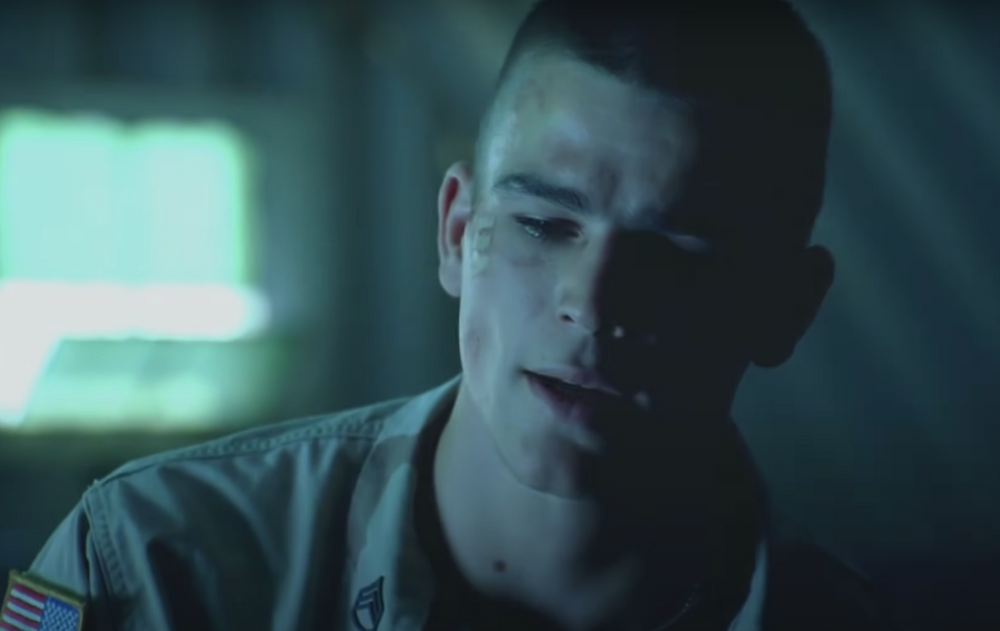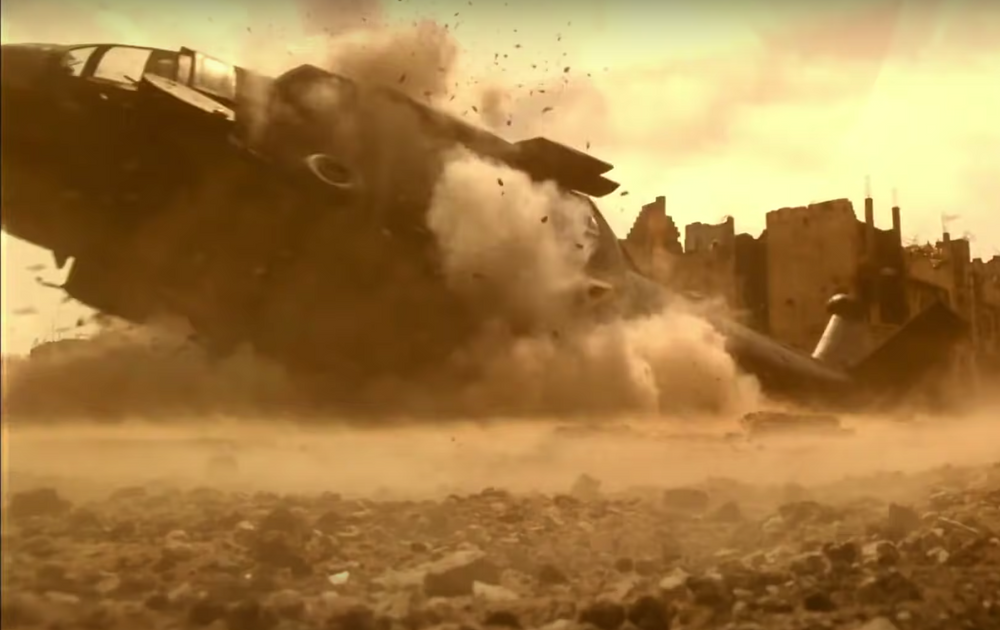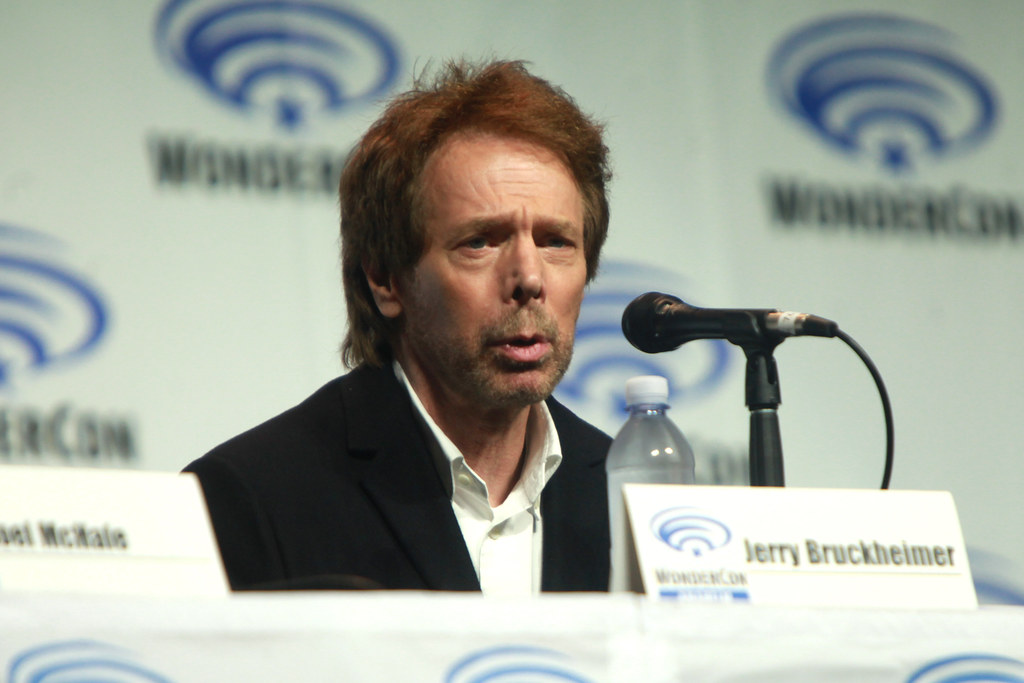Pentagon-Backed Movie, ‘Black Hawk Down’, Championed Military Intervention after 9/11
ANGLO AMERICA, 20 Sep 2021
Kevin Gosztola | The Dissenter – TRANSCEND Media Service

Sgt. Matt Eversmann played by Josh Hartnett in “Black Hawk Down.” (Screen shot from the promotional trailer for the film. Fair use for commentary purposes.)
9/11 and Its Impact on Cinema
18 Sep 2021 – During the 2004 presidential campaign, Vice President Dick Cheney defended President George W. Bush’s response to the 9/11 attacks and invoked “Black Hawk Down” at a town hall event in Milwaukee, Wisconsin.
“If you saw the movie ‘Black Hawk Down’ it portrays the events where we lost 19 soldiers in the battle in Mogadishu, and within weeks, we’d pulled all of our forces out of Somalia. So two lessons, one, they could strike us with impunity; and, two, if they did hit us hard enough, they could change [United States] policy.”
“What happened, of course, on 9/11 was they escalated, an ever higher level, killed 3,000 Americans, struck us here at home, and so that the approach that we’d taken before, that sort of, ‘well, it’s just a law enforcement problem,’ approach clearly didn’t work,” Cheney added.
The film, produced by Jerry Bruckheimer, was made with full support from the Pentagon before the September 11th attacks. But its release date was moved from March 2002 to December 2001—and a wide release in January 2002—precisely because it was a tale of American heroism that could sell audiences on the supposed necessity of military intervention.
It initially had two cards at the end that linked the film to the 9/11 attacks, but it apparently did not go over well with audiences at test screenings. The messaging was removed.
Tom Sherak, a partner at Revolution Studios who oversaw the release of the film, told the press, “People will take out of it what they want. If this was pre-September 11, maybe they’d take out, ‘War is hell; we should never go to war.’ But we’ve learned that we have to be involved. If it’s not us, who else is it?”
‘It’s Good For This Time’
If one wants to know how the U.S. military could wage war in seven different countries over the past 20 years, fuel terrorism and make the people less safe in all conflicts, and still have the unwavering support of the American people, look no further than films like this one.
Architects of the Iraq War—Cheney, Defense Secretary Donald Rumsfeld attended, and Deputy Defense Secretary Paul Wolfowitz, attended the premiere in Washington, D.C., on January 15, 2002. Oliver North, who conspired with drug traffickers to arm terrorists in what became known in the 1980s as the Iran-Contra scandal, was present as well.
“It’s a powerful film,” Wolfowitz told the Washington Post. “I think it’s good for this time. It reminds people what it’s all about.”
The film was adapted from journalist Mark Bowden’s 1999 book, Black Hawk Down: A Story of Modern War. However, the filmmakers stripped away much of the political and historical context, which won Bowden praise for his narrative of the raid by Army Rangers and Delta Force operators.
Sergeant Matt Eversmann (Josh Hartnett), a Ranger, leads a unit to capture two of General Mohamed Farah Aidid’s lieutenants. Aidid is introduced as a thug stealing humanitarian aid from the Somali people and committing genocide.
Operation Irene is outlined by General William Garrison (Sam Shepard). It is only supposed to last 30 minutes. The raid becomes a grisly disaster as two Black Hawk helicopters crash, and units in the market struggle to find their way out of the urban setting while militants fire on their column of tanks and surround soldiers tending to the wounded.
Commanders are unprepared to provide the support necessary to extract the men before more death occurs. Increasingly, soldiers panic and fire into crowds of people that cannot all be militants, but they often do not know where the shooting is coming from or who is shooting at them.
Every hour the young men have less and less ammunition and lack the medical equipment to save soldiers in need of evacuation or else they will die.
By the next morning, the Tenth Mountain division, along with a United Nations convoy, finally enters the market to ensure no soldiers, dead or alive, are left behind. Eversmann and remaining members of his unit follow on foot behind a convoy carrying the wounded to a UN “Safe Zone.” Somalis are shown outside the gate cheering for the Rangers as they arrive.
What Happened In Somalia Before ‘Black Hawk Down’
Much of the film was an aesthetic achievement. It won Academy Awards for editing and sound. It was nominated for Best Directing (Ridley Scott) and Best Cinematography (Slawomir Idziak). The cast is filled with the faces of actors, who were early in their careers, like Ewan McGregor, Orlando Bloom, Eric Bana, Jeremy Piven, and Nikolaj Coster-Waldau.
But what unfolded on screen was military industrial-complex myth-making. It hid the failure of the raid by obscuring the fact that Army Rangers and the Delta Force were deployed to capture Aidid and other leaders of his clan. They left with only two leaders.
Lidwien Kapteijns, an African history professor at Wellesley College in Massachusetts, wrote in an essay for Framing Africa: Portrayals of a Continent in Contemporary Mainstream Cinema,
“The film conceals the fact that U.S. political and military involvement in Somalia did not begin with the famine in 1992 but goes back to the early 1980s, when the U.S., in the context of the Cold War, began to financially and militarily support military dictator Mohamed Siad Barre, who increasingly used large-scale violence against civilians.”
The United States was in the middle of the Gulf War and did nothing for the people of Somalia after the brutal dictatorship collapsed in January 1991 and Aidid murdered “tens of thousands and expelled hundreds of thousands of Somali civilians.”
In the first three minutes of the film, the audience is told, in 1992, “Years of warfare among rival clans causes famine on a biblical scale. 300,000 civilians die of starvation. Mohamed Farrah Aidid, the most powerful of the warlords, rules the capital of Mogadishu. He seizes international food shipments at the port. Hunger is his weapon. The world responds. Behind a force of 200,000 U.S. Marines food is delivered and order is restored.”
As Kapteijns points out, the famine that triggered the 1992 intervention was the aftermath of the violence sparked by the fall of a U.S.-backed dictatorship. “When the U.S. sent its military into Somalia in early December 1992, it had been formally absent from Somalia for less than two years. The film gives no inkling of this earlier involvement.”
The opening credits jump to April 1993. They tell viewers Aidid “waits until the Marines withdraw and then declares war on the remaining U.N. peacekeepers. In June, Aidid’s militia ambush and slaughter 24 Pakistani soldiers and begin targeting personnel. In late August, America’s elite soldiers, Delta Force, Army Rangers, and the 160th SOAR are sent to Mogadishu to remove Aidid and restore order.”
But the background given to the audience skips over July 12, 1993, when U.S. helicopters attacked the house of Aidid’s interior minister. Leaders from the Habar Gidir clan were there to discuss peace proposals from Admiral Jonathan Howe, the U.S. special representative to the U.N.
According to Bowden‘s own reporting, ninety-year-old Sheik Aden and poet Moallim Soyan, along with other educated and well-respected men, were killed by missiles.
“The Abdi house attack became widely regarded as a symbol of the U.N./U.S. loss of direction in Somalia, from humanitarian champion to mass murderer,” journalist Natalia Megas wrote in 2019, as she recounted the civilian massacre that occurred prior to the “Black Hawk Down” incident.
Another reality hidden from the audience is that Aidid had a cozy relationship with Robert Oakley, the U.S. special envoy to Somalia appointed by President George Bush.
Alex de Waal, a British expert on African politics in the Horn of Africa, recalled in the New Left Review, “Oakley rented his large and expensive residence in Mogadishu from Aidid’s main financier Osman ‘Atto,’ used Aidid’s moneychangers for the lucrative business of converting U.S. dollars to Somali shillings, and gave the general a series of public relations coups by heralding ‘breakthroughs’ in peace talks that had in fact been negotiated by UN diplomats some months earlier.”
The film shows Atto being captured. The depiction is a caricature. He taunts interrogators, and says, “This is civil war. This is our war. Not yours.” In reality, he worked for American oil companies before Barre was toppled and was a wealthy owner of construction equipment that led Western companies to collaborate with him on projects. He did not smoke cigars or wear earrings.
‘I’m Going To Make A Movie, And Your Army Will Be Proud’
John Shelton Lawrence and John G. McGarrahan examine “Black Hawk Down” in their book, Why We Fought: America’s Wars in Film and History. They note Bruckheimer came to the Pentagon for personnel and equipment.
“He came into my office and said ‘General, I’m going to make a movie, and your Army will be proud of [it].’ He did, so we thank him,” General John M. Keane, the army’s vice chief of staff, recalled.
For $2.2 million, the Pentagon lent the production 100 troops and eight helicopters. The U.S. and Moroccan governments agreed to allow four Black Hawk helicopters and four Little Bird helicopters into Morocco, according to Lawrence and McGarrahan.
“To develop the proper military stances and maneuvers, actors trained at Fort Benning, Georgia (Rangers), Fort Bragg, North Carolina (Delta Force), and Fort Campbell, Kentucky (helicopters).”
Lawrence and McGarrahan noted that Keane, Army Chief of Staff General Eric Shinseki, and General Peter Pace of the Marine Corps, vice chair of the Joint Chiefs of Staff, were also at the D.C. premiere with Cheney, Rumsfeld, and Wolfowitz.
Their criticism highlights how the bloodshed, which preceded the time period covered in the film, was fueled by “leftover weapons from Somalia’s past as a Soviet and then an American client state” under President Jimmy Carter’s administration.
There are no developed Somali characters in the film, which reflects the contempt and ignorance of the troops who refer to them crudely as “skinnies.”
When Somalis do appear on screen, they appear as a barbarian horde, such as when they descend upon the helicopter crash sites. Or they are hungry and defenseless women and children, who need U.S. military intervention to survive. That is especially the message in the opening credits when their corpses are shown pornographically.
The confidential human source, who helps the troops uncover the location where the meeting will be held by Aidid, is credited as “Somali Spy.” The filmmakers do not seem to care why he took the risk to help U.S. military forces nor do the commanding officers seem willing to acknowledge the risk he is taking.
This is the only Good Somali character in the film. The others are all warlords, whose dialogue seems intended to illustrate a colonial perspective that these people will never be able to govern like a civilized Western democracy. Everything U.S. soldiers are doing will amount to nothing.
The Patriotic Fervor of ‘Black Hawk Down’
While promoting the film, Bruckheimer appeared on CNN with Scott, the film’s director. Judy Woodruff displayed no concern about the role of the Pentagon in determining the narrative of the film and gave American viewers something to quench their thirst for military action.
“How much of an obligation, Jerry Bruckheimer, do you and others in Hollywood, do you think, feel to be patriotic, particularly at a time like this?” Woodruff asked.
“Well, I think it is a very difficult time. We are at war. I would love to lift the spirits of our country, if we possibly can. But it all comes down to the story, because an audience will see through the kind of patriotic fervor unless it’s honest and true. And it comes down to what we are presented with,” Bruckheimer responded.
The audience score on Rotten Tomatoes is 88 percent. On IMDB, the audience rating is 7.7/10. (Both as of September 18, 2021.)
For the Los Angeles Times, critic Kenneth Turan described the film as a “triumph of pure filmmaking, a pitiless, unrelenting, no-excuses war movie so thoroughly convincing it’s frequently difficult to believe it is a stage re-creation.” Rolling Stone critic Peter Travers wrote, “This huge $90 million undertaking is a personal best for producer Jerry Bruckheimer, a triumph for Scott, and a war film of prodigious power.” And the Washington Posts’ Desson Thempson considered it a “compelling account of the 1993 Battle of Mogadishu.”
Renowned film critic Roger Ebert gave it four stars, noting, “Films like this are more useful than gung-ho capers like ‘Behind Enemy Lines.’ They help audiences understand and sympathize with the actual experiences of combat troops, instead of trivializing them into entertainments.”
Audiences did not see through the patriotic fervor because, as Ebert’s reaction illustrates, the film’s intricate computer graphics sequences paired with the young cast created hyper-realism that made them believe they were seeing a shot-for-shot recreation. They felt like they slogged their way through this two-and-a-half-hour film and survived the battle with the soldiers.
By the time the credits roll and one is told President Bill Clinton withdrew the Delta Force and Army Rangers two weeks later, viewers are supposed to feel like Dick Cheney—that a weak president emboldened terrorists and did not let forces that made great sacrifice complete their mission.
___________________________________________
 Kevin Gosztola is managing editor of Shadowproof, host of the “Dissenter Weekly,” co-host of the podcast “Unauthorized Disclosure,” and member of Society of Professional Journalists (SPJ)
Kevin Gosztola is managing editor of Shadowproof, host of the “Dissenter Weekly,” co-host of the podcast “Unauthorized Disclosure,” and member of Society of Professional Journalists (SPJ)
Go to Original – dissenter.substack.com
Tags: 9/11, Art, Cinema, Hollywood, Military Industrial Media Complex, Pentagon, US Military
DISCLAIMER: The statements, views and opinions expressed in pieces republished here are solely those of the authors and do not necessarily represent those of TMS. In accordance with title 17 U.S.C. section 107, this material is distributed without profit to those who have expressed a prior interest in receiving the included information for research and educational purposes. TMS has no affiliation whatsoever with the originator of this article nor is TMS endorsed or sponsored by the originator. “GO TO ORIGINAL” links are provided as a convenience to our readers and allow for verification of authenticity. However, as originating pages are often updated by their originating host sites, the versions posted may not match the versions our readers view when clicking the “GO TO ORIGINAL” links. This site contains copyrighted material the use of which has not always been specifically authorized by the copyright owner. We are making such material available in our efforts to advance understanding of environmental, political, human rights, economic, democracy, scientific, and social justice issues, etc. We believe this constitutes a ‘fair use’ of any such copyrighted material as provided for in section 107 of the US Copyright Law. In accordance with Title 17 U.S.C. Section 107, the material on this site is distributed without profit to those who have expressed a prior interest in receiving the included information for research and educational purposes. For more information go to: http://www.law.cornell.edu/uscode/17/107.shtml. If you wish to use copyrighted material from this site for purposes of your own that go beyond ‘fair use’, you must obtain permission from the copyright owner.

